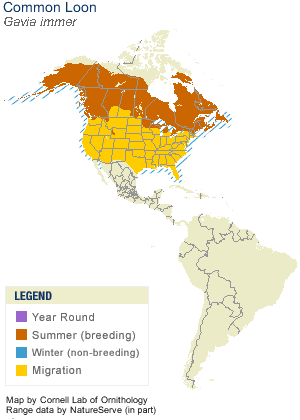Common Loon - Gavia immer

Family: Gaviidae, Loons
Description: 28-36" (71-91 cm). A large, heavy-bodied loon with a thick, pointed, usually black or dark gray bill held horizontally. In breeding plumage, head and neck black with white bands on neck; back black with white spots. In winter, crown, hindneck, and upperparts dark grayish; throat and underparts white.
Habitat: Nests on forested lakes and rivers; winters mainly on coastal bays and ocean.
Nesting: 2 olive-brown or greenish, lightly spotted eggs in a bulky mass of vegetation near water's edge, usually on an island.
Range: Breeds from Aleutian Islands, Alaska, and northern Canada south to California, Montana, and Massachusetts. Winters along Great Lakes, Gulf Coast, Atlantic and Pacific coasts. Also breeds in Greenland and Iceland.

Voice: Best-known call a loud, wailing laugh, also a mournful yodeled oo-AH-ho with middle note higher, and a loud ringing kee-a-ree, kee-a-ree with middle note lower. Often calls at night and sometimes on migration.
Discussion: The naturalist John Muir, who knew the Common Loon during his early years in Wisconsin, described its call as "one of the wildest and most striking of all the wilderness sounds, a strange, sad, mournful, unearthly cry, half laughing, half wailing." Expert divers, loons have eyes that can focus both in air and under water and nearly solid bones that make them heavier than many other birds; they are able to concentrate oxygen in their leg muscles to sustain them during the strenuous paddling that can take them as far as 200 feet (60 meters) below the surface. Their principal food is fish, but they also eat shellfish, frogs, and aquatic insects. In recent decades, acid rain has sterilized many lakes where these birds formerly bred, and their numbers are declining. A leading cause of loon mortality is lead poisoning caused by the ingestion of lead fishing tackle.
Updated at 8/24/2008 1:44:43 PM